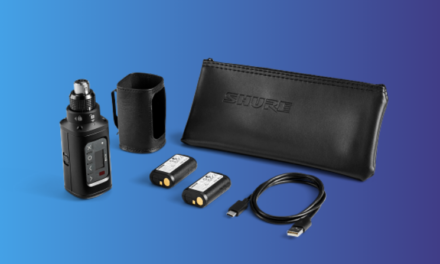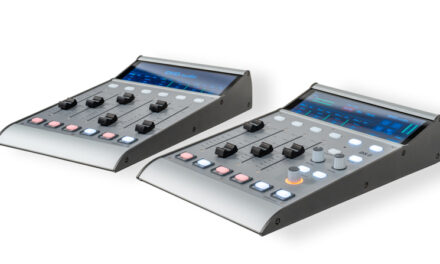1080p Succeeds 1080i as the Preferred Standard for OB TV Production
by Kevin Salvidge, Leader Europe Limited*
The transition from cathode-ray-tubes to flat-screen TV displays initiated an ongoing advance from standard definition and high definition to 4K-UHD and potentially even 8K. Great for consumers but an ongoing challenge for content producers keen to maximise the commercial longevity of their programmes. 4K SDR has been the default specification for practically every consumer TV receiver for several years, succeeded in turn by 4K HDR.
Every 4K TV set has a resolution upconverter but where to find true 4K content, let alone 4K HDR? Some is available online from providers such as Apple TV 4K, Amazon, Disney+ and Netflix. Feature and documentary producers were the first to embrace 4K HDR as the optimal format for today’s high-end streaming TV viewers and for archiving into a potential future world of affordable 8K consumer displays. But 4K sports broadcasting has proved very challenging for OB companies gearing to televise major events. This short article explains why OB companies in Europe, the USA and around the world have adopted 1080p as their preferred standard.
A large-scale OB project requires anything from 20 to 80 cameras, many of these outputting HD and SDR signals only, requiring conversion as well as being connected via long-distance wireless, fibre or copper cable to one or more production trucks. The cost of upgrading from HD to 4K for events of this scale is simply monstrous and difficult to recover. This is possibly the biggest challenge the broadcast industry faces at the present time.
For OTT service providers, it is logical to acquire and produce content in the best possible resolution, dynamic range and the widest space. Terrestrial and satellite broadcasters face a different hurdle: upgrading their facilities means quartering their capabilities by adopting quad 3G-SDI or migrating to 6G/12G-SDI or IP. Most consumers struggle to see the difference between HD and UHD resolution, notably in European homes where the average viewing distance is three metres and the most common display size is 55 inches.
The 1080p solution
An increasing number of sports broadcasters are adopting 1080p for delivery to the consumer and relying the viewer’s set-top-box or display device to do the upconversion to UHDTV resolution. The original production for Teir 1 acquisition will remain at 4K HDR, maximising the revenue-generating life cycle of the content. Programmes are then converted to 1080p before transmission. The upgrade to 1080p, coupled with HDR, gives consumers a higher quality product even though not true 4K.
The result is a potentially massive saving in equipment rental or capital-investment cost. 1080p also reduces the need for data compression compared with 4K. Properly monitored from the point of acquisition via carefully matched cameras at the front end and on through the production and delivery chain, 1080p HDR with low compression is capable of very good quality. Uncompressed 1080p HDR is equivalent to 3 gigabit/s which is within the capabilities of many HD-SDI production facilities. The resultant signals upconvert very effectively to 4K HDR or can be downconverted for terrestrial or satellite HD SDR transmission.
JPEG XS
JPEG XS offers lightweight compression that preserves the perceived visual quality very effectively compared to an uncompressed stream. It is designed to handle compression ratios of up to 10:1. As an operational example, JPEG XS allows SDI cables to carry 4K60 over a single 3G-SDI at 4:1. It alternatively allows lightly compressed 4K60 content to be delivered via 1G Ethernet and 8K60 over 5G or 10G Ethernet. If you want to learn more about JPEG XS and its implementation, the Leader / Grass Valley seminar at https://www.youtube.com/watch?v=UGRrAMUi-XU might be of interest.
HDR to SDR conversion – handle with care!
HDR is now well established in cinema and high-end TV production. The next major challenge is live HDR production where an SDR programme feed is required. To quote Pablo Garcia, Managing Director of Cromorama: “We are now defining the workflows for the next 20 years when it comes to simultaneous HDR/SDR live production. Having a test instrument that can display multiple transfer characteristics is vital as high-performance colour management tools start to establish themselves within the live production community.”
Easing the transition to IP
IP is now widely used as a supplement or addition to SDI but the media industry appears to be splitting between SMPTE ST2110 for tier one broadcast production and NDI for tier two. The Leader / PHABRIX booth theme at IBC 2023 in September was ‘Making your transition smooth – SD to HD, HD to UHD, SDR to HDR, SDI to IP and On-Premises to Cloud’. All visitors to the booth stated that their next generation of test and measurement products must be IP-ready.
Irrespective of where our customers are on their technology migration, Leader / PHABRIX have a test and measurement solution that will ease the transition. By retaining traditional test and measurement tools like the waveform and vectorscope, years of SDI fault-finding experience can be seamlessly applied to new IP facilities and cloud-based productions.
The future of sports TV production
Forecasting the future of sports TV production is complicated by the wide horizon of divergent paths the industry could take. Esports established a strong following in the early 2000s, both for players and spectators. Though the majority of sports fans will continue to prefer watching matches between real rather than virtual contestants, esports have almost limitless potential for integration with traditional forms of television entertainment. Virtual sports are already encouraging virtual OB techniques. We have also seen gaming-style products for football where a gantry level railcam is used to move along the pitch, replacing or supplementing a traditional main camera on the halfway line. With a railcam, the ball can always be in the centre of the shot.
Automated camera tracking is another development avenue, gaining increasing acceptance in studio environments and offering great potential as a way to maximise sports OB productivity.
Internet-connected production could be viewed as a future path though in fact has become mainstream. New opportunities emerge with every passing trade show as cloudware service-providers enhance their range of offerings.
8K. Will it ever become a seriously attractive format for content producers and broadcasters? For the former, certainly. For the latter, not until compression algorithms become efficient enough to allow 8K content to be delivered at sensibly low data rates. AI has been mooted as a route towards ultra-clean 8K data compression but then you have to ask who needs the massive screens which 8K makes possible? There is one answer: viewers of wrap-around TV, whether encircled by curved screens or wearing head-up displays. I am not holding my breath on that one but, if it happens, HUDs will merit much higher resolution than the 4K x 4K per eyepiece specimens currently being offered. If HUD TV really is the future of TV in general and sports TV in particular, the resolution will need to be four times higher than 8K to avoid visible pixelation.
HDR/SDR bidirectional converter
At the 14-17 April 2024 NAB Show in Las Vegas, we will demonstrate additions to the feature set of our ZEN Series range of test and measurement instruments. Among these will be a new bidirectional conversion tool which allows HDR content to be viewed in SDR and vice versa. Processing is based on the desired 3D color lookup table uses 33-point tetrahedral interpolation which can be imported via plug-in USB memory. The new 3D LUT capabilities will simplify live production workflows by integrating HDR/SDR conversion for applications such as camera shading and HDR supervision. On-set DITs will be able to integrate 3D LUTs instead of relying on external LUT boxes and postproduction colorists can view the 3D LUTs for OTT and OTA deliverables prior to creating the final master.
SDR ‘Full Range’ display
SDR Full Range is becoming a popular workflow style for digital cinematography and television drama production, not least in Hollywood. SDR as normally transmitted by broadcast television channels encompasses luminance code value levels 64 to 940 (Narrow / Legal Range) of the 1024 maximum which can be accommodated in a 10-bit digital stream. SDR Full Range encompasses code value levels 4 to 1019, allowing higher dynamic range to be delivered without requiring the adoption of full HDR at any point in the signal flow from initial production to home viewing. Leader’s ZEN Series already provides the tools necessary for SDR and HDR test and measurement. This new feature extends SDR Full Range support to display black error, CIE, gamut error, histogram, level error, audio/video timing offset, noise level, test signals, vector and waveform. Also fully supported for SDR Full Range are CINELITE and CINEZONE, five-bar, frame capture (DPX, TIFF) and image quality adjustment.
ARRI and RED camera tools added to Leader CINEZONE
Leader ZEN Series instruments also gain support for ARRI and RED cameras to its industry-proven CINEZONE real-time false colour exposure display. These new facilities are an expansion of the CINEZONE/CINELITE toolset which comes as standard on all Leader ZEN Series models. CINELITE is a built-in light meter that gives on-set production and postproduction facilities the ability to analyze a single pixel or small area of the image in either luminance, RGB, code values or f-stops. CINEZONE overlays false colors on the image. It colors the strong and weak areas of brightness on the picture display so an operator can judge the luminance conditions of the entire screen. This helps confirm that a camera is reproducing what is expected. The ARRI (User-A) and RED (User-R) features replicate the false color display tools that were previously only visible on the ARRI or RED cameras so they can be viewed by production staff without interfering with the camera setup and operation. Both CINEZONE and CINELITE can be displayed simultaneously on all Leader ZEN Series products.
* Kevin Salvidge commenced his broadcast industry career in 1986 as a commissioning engineer at Marconi Instruments, progressing to Sony Transcom, Tektronix, GVG/Thomson, Sony Broadcast, and PlayBox. He joined Leader Europe Limited in August 2015 and is now Sales Engineering & Technical Marketing Manager.






